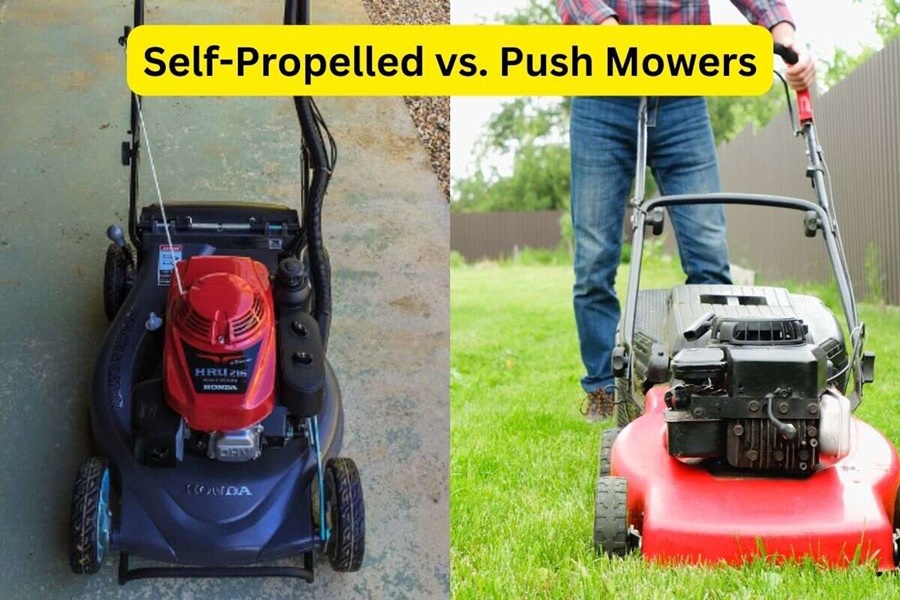When it comes to lawn maintenance, the type of mower you choose can make a significant difference in efficiency, effort, and results. Two of the most common options for residential lawn care are push mowers and self-propelled mowers. While both are designed to trim grass effectively, they differ in functionality, power, convenience, and cost. In this guide, we’ll explore the key differences between push mowers and self-propelled mowers, so you can make the best decision for your lawn care needs.
Understanding the Basics: Push Mower vs Self-Propelled Mower
What Is a Push Mower?
A push mower is a manually operated lawn mower that requires the user to physically push it across the lawn. It does not include any motorized assistance for movement; the power comes solely from your own effort. Push mowers can be either gas-powered, electric, or reel-style (manual blade rotation), and are typically lighter and more affordable than self-propelled options.
What Is a Self-Propelled Mower?
A self-propelled mower, on the other hand, is equipped with a motor that drives the wheels, allowing it to move forward with minimal physical effort. The user only needs to guide the direction. These mowers can be front-wheel drive, rear-wheel drive, or all-wheel drive, and they often come with variable speed settings to match your walking pace.
Key Differences Between Push and Self-Propelled Mowers
1. Effort and Ease of Use
- Push Mowers: Require full manual effort. Best suited for flat and small lawns. Over time, pushing can become tiring, especially in hot weather or on uneven terrain.
- Self-Propelled Mowers: Require significantly less effort. The motor does the hard work, making it ideal for larger yards, hills, and uneven surfaces.
Verdict: For those looking for minimal physical strain, self-propelled mowers are the clear winner.
2. Power Source Options
- Push Mowers: Available in manual reel, corded electric, battery-powered, and gas models.
- Self-Propelled Mowers: Mostly available in gas-powered and battery-powered models. These typically have higher torque to power both the blades and the wheels.
Verdict: Self-propelled mowers usually offer more powerful engines, making them better for thicker grass and tougher terrain.
3. Maneuverability
- Push Mowers: Due to their lightweight construction, they are easier to maneuver around flower beds, trees, and obstacles.
- Self-Propelled Mowers: Heavier and bulkier, especially gas-powered models, which can make tight turns more challenging.
Verdict: If your lawn has many obstacles or tight spaces, a push mower offers better maneuverability.
4. Maintenance Requirements
- Push Mowers: Fewer mechanical parts, especially in manual or electric models, means less maintenance.
- Self-Propelled Mowers: More complex due to the transmission system and drive mechanisms. These may require regular servicing, including belt adjustments, oil changes, and transmission checks.
Verdict: Push mowers win in terms of low maintenance and simplicity.
5. Cost Comparison
- Push Mowers: Generally the most affordable option, with prices ranging from $80 to $300 depending on the model.
- Self-Propelled Mowers: More expensive due to additional features. Expect to pay between $300 and $800+ for quality models.
Verdict: For budget-conscious buyers, push mowers are a more economical choice.
6. Lawn Size Suitability
- Push Mowers: Ideal for lawns up to 1/4 acre.
- Self-Propelled Mowers: Designed for medium to large lawns (1/4 to 1 acre or more).
Verdict: The larger your lawn, the more advantageous a self-propelled mower becomes.
7. Cutting Performance
- Push Mowers: Can perform well, especially if maintained properly. However, they may struggle in thick, tall, or wet grass.
- Self-Propelled Mowers: Usually have superior blade speed and torque, cutting through dense or overgrown grass with ease.
Verdict: For consistently clean, even cuts on varying terrain, self-propelled mowers outperform.
Pros and Cons of Push Mowers
Pros:
- Lightweight and easy to store
- Lower cost and maintenance
- Better maneuverability in tight spaces
- Quiet operation in electric or manual models
Cons:
- Requires physical effort to operate
- Not suitable for hills or large lawns
- May struggle with tall or dense grass
Pros and Cons of Self-Propelled Mowers
Pros:
- Less physical exertion required
- Ideal for large or hilly lawns
- More cutting power and consistent performance
- Variable speed settings for comfort
Cons:
- Heavier and more expensive
- More maintenance required
- Not as agile in tight spots
Best Use Cases for Each Type
Choose a Push Mower If:
- You have a small, flat lawn
- You’re working on a tight budget
- You prefer a low-maintenance tool
- You want a lightweight mower for easy storage and handling
Choose a Self-Propelled Mower If:
- Your lawn is medium to large in size
- You have slopes, hills, or uneven ground
- You want a quicker, easier mowing experience
- You’re willing to invest in comfort and convenience
Top Brands and Models to Consider
Recommended Push Mowers:
- American Lawn Mower Company 1204-14 (Reel)
- Greenworks 25022 (Corded Electric)
- Sun Joe MJ401C (Battery-Powered)
- Craftsman M105 (Gas-Powered)
Recommended Self-Propelled Mowers:
- Honda HRX217VKA (Gas, Rear-Wheel Drive)
- EGO Power+ LM2135SP (Battery, Self-Propelled)
- Troy-Bilt TB330 (Gas, Front-Wheel Drive)
- Toro Recycler 20340 (Gas, Personal Pace)
Conclusion
The decision between a push mower and a self-propelled mower depends largely on your lawn size, terrain, physical condition, and budget. For small, flat yards, a push mower is cost-effective and practical. But if you have a larger lawn, uneven terrain, or simply want to reduce physical strain, investing in a self-propelled mower is a smart, long-term choice.








Leave a Reply